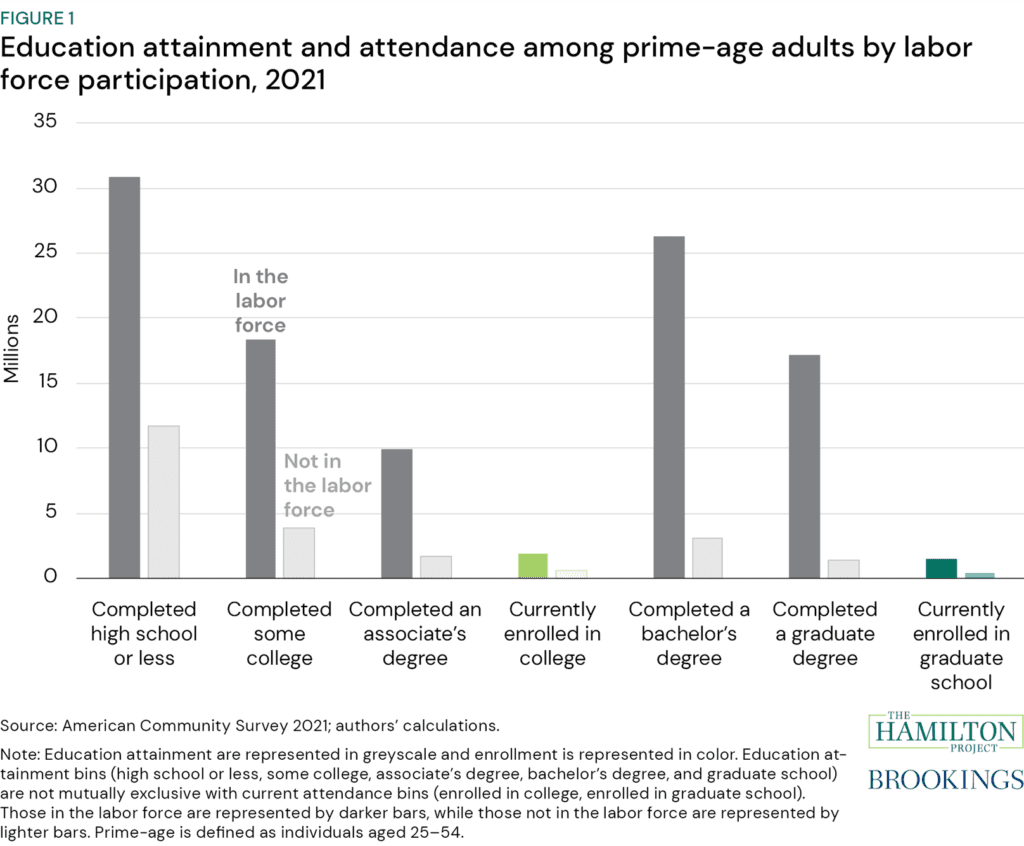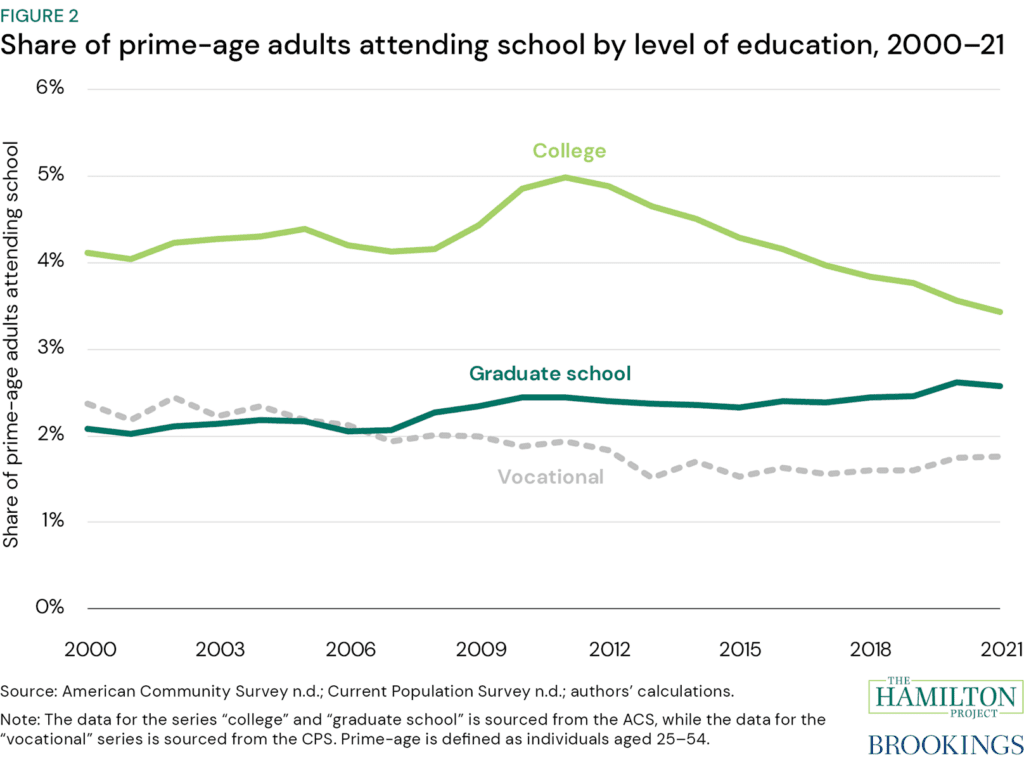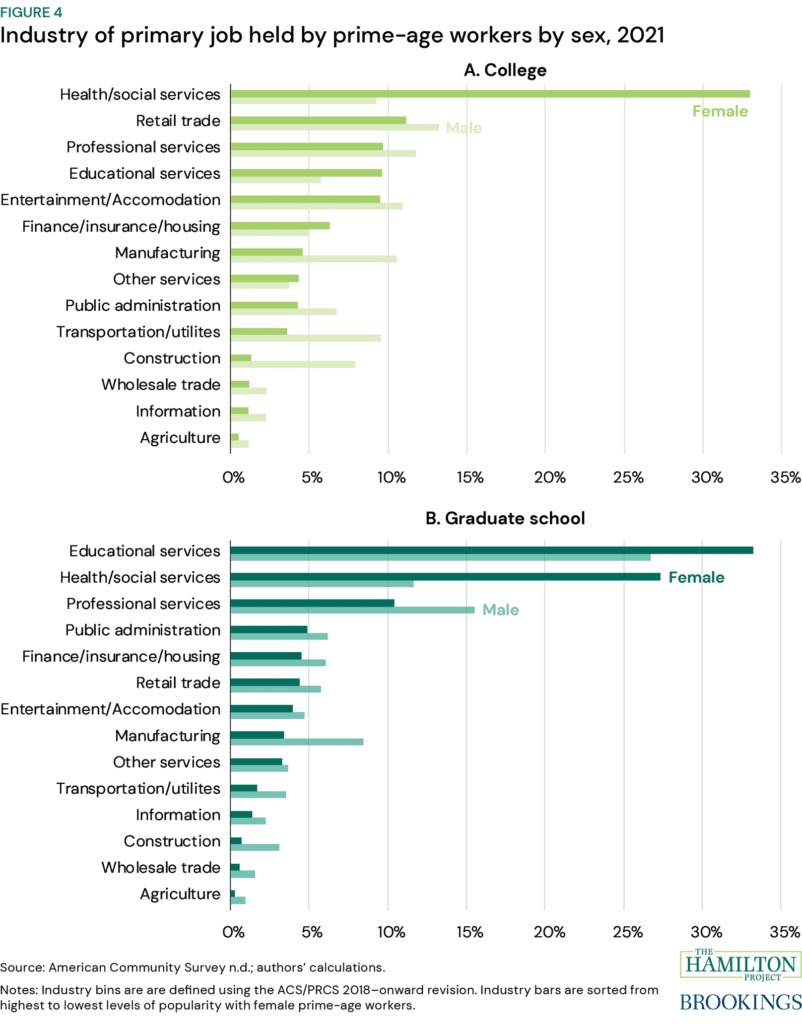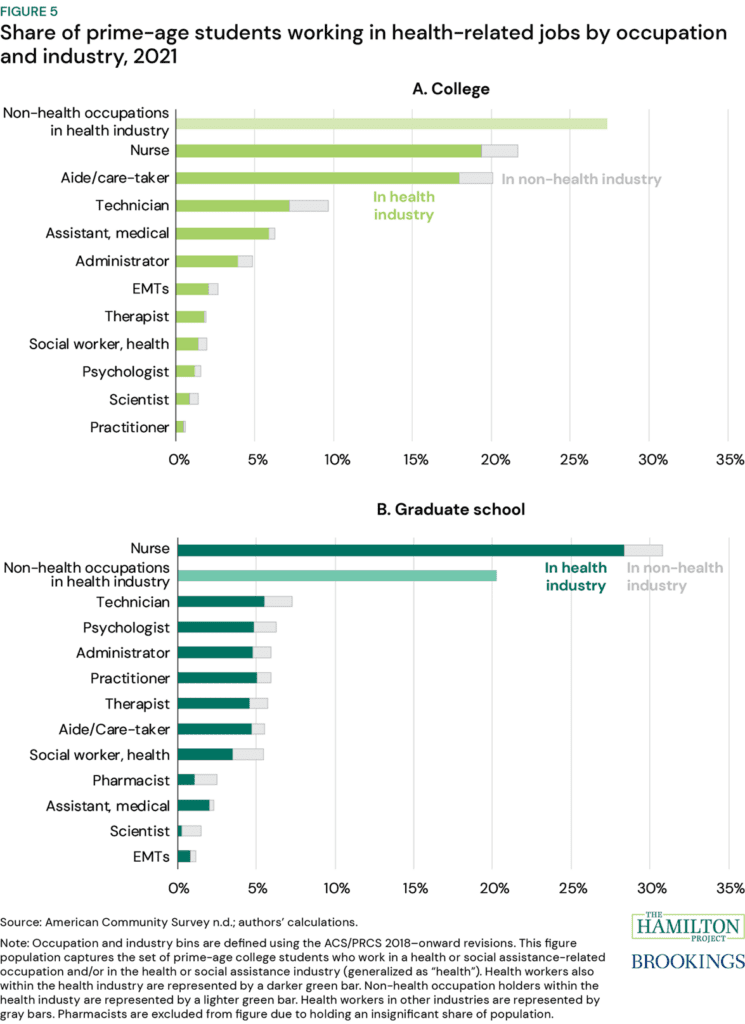In 2021, an estimated 4.3 million prime-age adults (individuals aged 25 to 54) in the U.S. were enrolled in postsecondary education (college and graduate school), amounting to 7.3 percent of prime-age adults. That share has fluctuated with economic conditions but has overall trended downward over the last two decades. When there are fewer jobs and fewer work hours available, the opportunity costs of taking time to continue education are lower. Nonetheless, among prime-age adults who are in school, typically more than three-quarters also have a job. Indeed, the share of students in the labor force has changed little over the last two decades, averaging 78 percent for prime-age individuals in college and 81 percent for those in graduate school. We find that working prime-age students are concentrated in health industries and occupations.
Has postsecondary enrollment among the prime-age population changed?

Figure 1 shows the distribution of educational attainment for prime-age adults in 2021 as well as whether they are working and whether they are currently in school. Among prime-age adults with less than a bachelor’s degree (including those currently enrolled in college), roughly 61 million are in the labor force and 18 million are not in the labor force; more than two million of those without a bachelor’s degree were enrolled in college in 2021. Forty-three million people in the labor force and not in the labor force have a bachelor’s degree or more; 19 million people, irrespective of their labor force status, are enrolled in graduate school. Three million people are currently enrolled in college or graduate school and in the labor force–in total, 80 percent of prime-age adults who are enrolled in postsecondary education are in the labor force. Among the remaining 20 percent in school and not working, about 600,000 are in college and about 400,000 are in graduate school.

Figure 2 shows the share of prime-age individuals enrolled in postsecondary education programs, including vocational education, from 2000 to 2021. The share of prime-age individuals enrolled in college has been the largest and most variable out of all three programs of study. Leading up to the Great Recession, enrollment hovered just above 4 percent of the total population, but in 2008 enrollment levels began to rise, peaking at just under 5 percent in 2011. This rise is consistent with the declining opportunity cost of attending college when the labor market was weak. In addition, through the American Recovery and Reinvestment Act, the government increased access to financial aid, which lowered the contemporaneous cost of college through both grants and loans.
Since its peak in 2011, prime-age college enrollment has declined steadily by about 0.16 percentage points each year, including between 2020 and 2021. Compared to the Great Recession, the recession of 2020 was much shorter and the subsequent recovery in the labor market was much stronger. In addition, given the wide-ranging negative effects that the pandemic had on higher education, the return to college was likely lower than in a typical recession. As a result, the incentives to enroll in school, as opposed to participating in the labor market, seem to have continued to decline in the past few years.
From 2000 to 2021, graduate school attendance among prime-age individuals has generally risen while vocational school attendance has trended downward. From 2000 to 2008, graduate school attendance hovered at 2 percent. Unlike college enrollment, graduate enrollment has gradually increased since 2011, peaking at 2.6 in 2021.
Are there enrollment changes among working students?

We next explore the demographics of prime-age individuals who are both enrolled in school and working. Figure 3 shows the share of working students by sex. Figure 3a shows differences in postsecondary program, and figure 3b shows differences in college enrollment by parental status.
For the past two decades, more women are both working and in postsecondary education compared to men. Notably, as of 2018, the share of prime-age women working and enrolled in graduate school has surpassed the share of prime-age men who are working and enrolled in college. Further, while women’s graduate school enrollment continues to trend upward, the share of men enrolled in graduate school saw a decline between 2020 and 2021.
In addition, while working and going to college is more common for women without children than women with children, women with children are consistently more likely to enroll in college and work than men without children. This pattern is consistent when looking at the enrollment patterns for graduate school (not shown). The decline since 2011 in the share of prime-age individuals working and attending college most prominently reflected a decline among mothers with children, in addition to less steep declines for mothers without children and men.
Where do working students work?
Prime-age adults who are both in school and working are concentrated in a few industries. Figure 4 shows the industry of the primary job held by working prime-age students in 2021 by college (figure 4a) or graduate school (figure 4b). More than a quarter of male and a third of female prime-age graduate students work in educational services, which probably reflects that many students getting graduate degrees teach at their institutions. Across both college and graduate programs, many female students work in health care and social services, while men are concentrated in professional, retail, and educational services.

We now investigate the occupations held by those prime-age students who work in the health care and social assistance industry. In a Hamilton Project policy proposal, E. Kathleen Adams and Sara Markowitz detail how health professions operate on a continuum of credentialing, training, and licensure—there are many opportunities to “move up” to new jobs, more responsibility, and better pay within the sector while working in the sector. Their proposal argues for even greater “scope of practice” for the most advanced degree holders—physician assistants and advanced practice registered nurses—meaning a loosening of restrictions on which tasks these practitioners can do.
Figures 5a and 5b describe which health care workers are also enrolled in formal postsecondary education. We cannot capture differential kinds of professional development that may lead to interim health care-related credentials, such as certificates.
The dark green and gray bars in figure 5a represent the share of those who work either in health-related occupations in the health care industry (dark green) or in a different industry (gray), such as a nurse for an elementary school or physician on-call for a private tech company. The light green bar at the top of the figure represents the share of occupations held within the health/social industry that are not health-related, such as computer and information technicians.
We find that more than 40 percent of prime-age students in college who have a health-related occupation and/or work in the health industry are either nurses or aides/caretakers. Overall, one in ten prime-age college students are nurses or health aides.
Figure 5b conducts a similar analysis of occupations to figure 5a but for graduate students. Almost a third of prime-age graduate students working in health-related occupations or industries are nurses. One possible explanation is that most health care positions require licensing and credentials. In contrast, those who work in medical roles that require more training and education are less likely to be enrolled in college.

The Hamilton Project on continuing education
Despite improvements in technology that make going to school while working more feasible, there is little evidence that those improvements have resulted in greater enrollment among working adults. Notably, adults who are in school and working are concentrated in industries and occupations that are organized to reward continuing education. We find less evidence that those who are in school while working are doing so for general human capital investment or in order to switch fields or jobs.
The Hamilton Project has published proposals for improving health care career ladders (“Removing anticompetitive barriers for advanced practice registered nurses and physician assistants” by E. Kathleen Adams and Sara Markowitz; “An industrial policy for good jobs” by Dani Rodrik). In addition, The Hamilton Project has proposals to make completing postsecondary education easier for student-parents (“Helping women to succeed in higher education: Support student-parents with child care” by Bridget Terry Long), distance learners (“Building tomorrow’s workforce today: Twin proposals for the future of learning, opportunity, and work” by Richard Arum and Mitchell Stevens), and the unemployed (“Labor force to lecture hall: Pell grants and postsecondary policies in response to job loss” by Sarah Turner).




